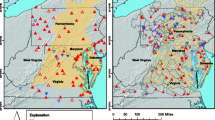Abstract
The water temperatures of four English chalk streams which have a large groundwater component in their discharge were studied. Simple linear regression models were used to described mean monthly water temperature as a function of mean monthly air temperature. There were no significant between-year differences within rivers, in the case of the Lambourn, Winterbourne and Tadnoll. For the Frome, only one year out of the eight studied was significantly different from the others. Further analysis revealed that there were no significant differences between the Tadnoll, Winterbourne and Lambourn, and that the relationship between maximum monthly water temperature and air temperature was best described by the equation y = 4.29 + 0.55x. Using this pooled equation to predict river temperatures for the three rivers studied gave mean deviations of less than 1 °C from the observed temperatures. It was concluded that linear regressions of the type presented are sufficiently accurate to predict the thermal regimes of rivers for a variety of limnological purposes. They can also be used to predict the temperature response of chalk streams to increased air temperatures that may be produced by climate change. The results predict that chalk streams would show less increase in temperature than other running waters under these circumstances.
Similar content being viewed by others
References
Crisp, D. T., A. M. Matthews & D. F. Westlake, 1982. The temperature of nine flowing waters in southern England. Hydrobiologia 89: 193–204.
Dickinson, R. E. & R. J. Cicerone, 1986. Future global warming from trace gases. Nat. Lond. 319: 109–115.
Ham, S. F., J. F. Wright & A. D. Berrie, 1981. Growth and recession of aquatic macrophytes on an unshaded section of the River Lambourn, England, from 1971–1976. Freshwat. Biol. 11: 381–390.
Holmes, N. T. H. & B. A. Whitton, 1981. Phytobenthos of the River Tees and its tributaries. Freshwat. Biol. 11: 139–163.
Illies, J., 1961. Versuch einer allgemeinen biozonotischen Gliederung der Fliessgewasser. Int. Revue ges. Hydrobiol. 46: 205–213.
Jeppesen, E. & T. M. Iversen, 1987. Two simple models for estimating daily mean water temperatures and diel variations in a Danish low gradient stream. Oikos 49: 149–155.
Kahlig, P., 1978. Simple non-linear models for the cooling of well-mixed rivers. Wat. Air Soil Pollut. 10: 61–70.
Kowalczewski, A. & T. J. Lack, 1971. Primary production and respiration of the phytoplankton of the Rivers Thames and Kennet at Reading. Freshwat. Biol. 1: 197–212.
Krajewski, W. F., A. K. Krajewski & W. J. Grenney, 1982. A graphical technique for river water temperature predictions. Ecol. Model. 17: 209–224.
Mann, R. H. K., 1973. Observations on the age, growth, reproduction and food of the roach Rutilus rutilus (L.) in two rivers in southern England. J. Fish Biol. 5: 707–736.
Minshall, G. W., 1968. Community dynamics of the benthic fauna in a woodland springbrook. Hydrobiologia 32: 305–339.
Minshall, G. W., 1969. The Plecoptera of a headwater stream (Gaitscale Gill, English Lake District). Arch. Hydrobiol. 65: 494–514.
Pittock, A. B., 1988. Actual and anticipated changes in Australia's climate. In Pearman, G. I., (ed.) Greenhouse: Planning for environmental change. CSIRO. Melbourne: 35–51.
Smith, K., 1981. The prediction of river water temperatures. Bull. Sci. Hydrol. 26: 19–32.
Sokal, R. R. & F. J. Rohlf, 1969. Biometry. W. H. Freeman & Co. San Francisco. 776 pp.
Vannote, R. L. & B. W. Sweeney, 1980. Geographic analysis of thermal equilibria: a conceptual model for evaluating the effect of natural and modified thermal regimes on aquatic insect communities. Am. Nat. 115: 667–695.
Vugts, H. F., 1974. Calculation of temperature variations of small mountain streams. J. Hydrol. 23: 267–278.
Ward, J. V., 1985. Thermal characteristics of running waters. Hydrobiologia 125: 31–46.
Ward, J. V. & J. A. Stanford, 1982. Thermal responses in the evolutionary ecology of aquatic insects. Ann. Rev. Ent. 27: 97–117.
Westlake, D. F., H. Casey, H. Dawson, M. Ladle, R. H. K. Mann & A. F. H. Marker, 1972. The chalk stream ecosystem. In Kajak, Z. & A. Hillbricht-Ilkowska (eds.) Productivity problems of freshwaters, Proc. IBP/UNESCO Symp. Kazimierz Dolny, May 1970. Polish Scientific Publishers, Warszawa-Krakow: 616–635.
Wigley, T. M. L., P. D. Jones & P. M. Kelly, 1980. Scenarios for a warm, high-CO2 world. Nat. Lond. 283: 17–21.
Woolland, J. V. & J. W. Jones, 1975. Studies on grayling, Thymallus thymallus L., in Llyn Tegid and the upper River Dee, North Wales. I. Age and growth. J. Fish Biol. 7: 749–773.
Zar, J. H., 1984. Biostatistical Analysis. 2nd. Edn. Prentice Hall, Inc. New Jersey. 620 pp.
Author information
Authors and Affiliations
Rights and permissions
About this article
Cite this article
Mackey, A.P., Berrie, A.D. The prediction of water temperatures in chalk streams from air temperatures. Hydrobiologia 210, 183–189 (1991). https://doi.org/10.1007/BF00034676
Received:
Revised:
Accepted:
Issue Date:
DOI: https://doi.org/10.1007/BF00034676




